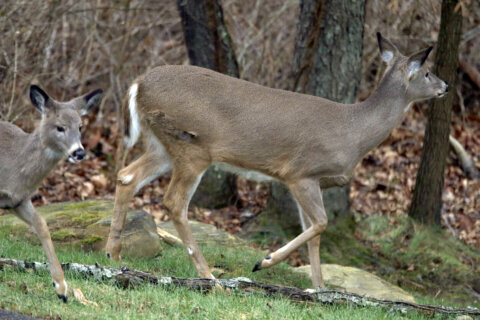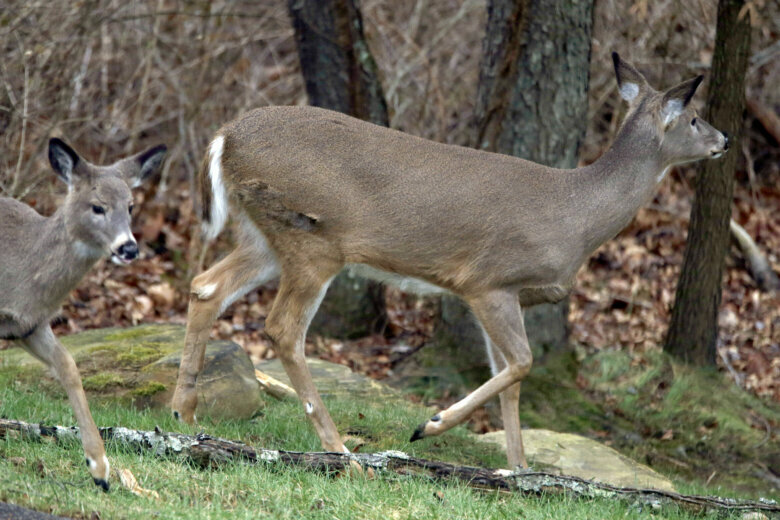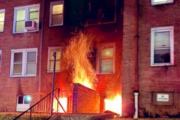
White-tailed deer are eating too many plants, trees and other forestation in the D.C. area, and the National Park Service wants the public’s help in deciding how to control them.
During a meeting on Tuesday, the park service introduced a first-ever program for the area — for National Capital Parks-East to manage the deer using lethal methods.
“We have not pursued deer management in National Capital Parks, specifically within National Capital Parks-East,” said Michael Commisso, chief of resource management for National Capital Parks-East. “However, we are one of the last parks to really pursue it within the region.”
The U.S. Forest Service said that deer densities above 20 deer per square mile inhibit tree regeneration.
For the parks in the D.C. area where the park service has been conducting a majority of the deer density surveys, Scott Bates, regional wildlife biologist with the park service, said there is about 150 deer per square mile in Fort Dupont Park in D.C., 90 per square mile in Greenbelt Park in Maryland, 85 per square mile in Piscataway Park in Maryland, and 50 per square mile in Fort Washington Park in Maryland.
After deer management in Catoctin Mountain Park, there was a 13-fold increase in tree seedling density, the park service said.
“In 2009, the deer density in Catoctin was probably about 140 to 150 per square mile, and by 2015 it was about 100 per square mile,” Bates said.
The proposed plan includes controlled-harvest programs through sharpshooting with firearms or archery, as well as capture and euthanasia.
Commisso said that the agency will then test venison and donate it directly to area food banks. He also said that volunteers won’t be able to help with the management because of safety reasons.
The park service said that there are no nonlethal deer management controls that are effective in an open, free-ranging deer population; but it did say other ways to manage them, if those methods pop up, would be considered.
And why is the deer population in the D.C. area increasing?
“Habitat, developments, as well as a lack of hunting opportunities, in urban areas all contribute,” Bates said.
Safety measures for the proposal include working at night when parks are closed, advising commuters and cyclists to plan other routes, working away from populated areas with safety buffers, temporarily closing roads, stationing NPS personnel at closures, enforcing nighttime trails closures, and posting signs on closed trails/roads and bulletin boards.
They will also be using non-lead ammunition with shorter travel distance.
To find the deer, the park service said that infrared heat scanners and night-vision goggles will be used, as well as elevated positions to provide downward, angled shots.
The proposed parks in Maryland include:
- Fort Washington Park
- Fort Foote Park
- Piscataway Park
- Oxon Cove Park
- Harmony Hall Park
- Greenbelt Park
- Baltimore-Washington Parkway
- Suitland Parkway
The proposed parks in D.C. include:
- Anacostia Park
- Kenilworth Park and Aquatic Gardens
- Fort Mahan
- Fort Dupont
- Fort Davis
- Fort Chaplin
- Fort Stanton
- Fort Ricketts
- Fort Greble
- Battery Carroll
- Shepherd Parkway
The feedback period started Tuesday and continues through July 15. Any changes to the plan will take place from July through September.
The public comment period on that final plan would then be for 30 days starting in October. If no major changes are needed, the program could start in November.
“This is going to be a long-term project,” Bates said. “We will probably be able to keep the deer densities around 20 per square mile. That may take a few years, but eventually we’ll get there.”
The public is encouraged to comment on the project on the park service website.









